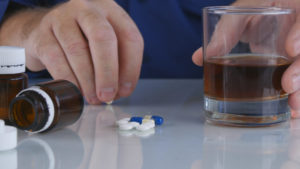Dilaudid is an opioid narcotic that is usually prescribed by a medical professional to a person who is experiencing moderate to severe pain.
Prior to using Dilaudid, most patients have already tried pain relievers such as morphine or oxycodone. A patient may be prescribed a stronger analgesic if their body did not respond to the prior medication or if they failed to experience a satisfying level of pain relief.
How Do You Take Dilaudid?
Dilaudid can be taken in the following forms:
- Tablet
- Oral liquid
- Intravenous injection
The brain responds to the medication by changing the way the body feels and reacts to pain.
How Is Dilaudid Classified?

Dilaudid is the brand name for the drug hydromorphone, and it is only available by prescription. Those suffering from cancer or extreme physical injuries can greatly benefit from a drug of this magnitude.
The pain-relieving effects of this drug are so strong that the U.S. Drug Enforcement Administration (DEA) classifies Dilaudid as a Schedule II controlled drug. This indicates that Dilaudid is a potent drug that has medicinal uses but also a high probability of dependence and abuse. Patients can build a tolerance to Dilaudid in approximately two to three weeks.
Mixing Dilaudid With Other Substances
Those who use Dilaudid for recreational purposes and do not abide by usage recommendations from a medical professional often mix the opioid with other drugs. This increases the degree of danger and life-threatening ramifications that may occur.
For example, when someone mixes Dilaudid with benzodiazepines or alcohol, or other central nervous system (CNS) depressants, there is a high probability of lethal depression of breathing and heart rates. In other words, there is a high plausibility of death.
Can Accidental Addiction Occur?

Continued use of Dilaudid can result in addiction even when patients do not intend for this to happen. The ongoing use of the drug can create changes in the brain that can compromise someone’s ability to manage impulses and self- control.
When someone is addicted to a drug, brain changes can be persistent. Drug addiction is considered to be a relapsing disease. People in recovery are at a greater risk of returning to use of their drug of choice. Even if someone has been sober for several years, relapse is still possible.
Addiction is misunderstood by many as a lack of moral integrity or willpower. Those who suffer from addiction are dealing with a complex disease. There is no cure for addiction, but they can learn to effectively manage the disease, usually with professional help.
What Is the Prevalence of Opioid Use?
The ubiquity of opioid prescriptions contributes to the ongoing opioid crisis in the United States. This prevalence of such prescriptions has led to numerous hospitalizations. Prescription opioids contribute to 40 percent of all opioid-related deaths in the United States.
Despite doctors becoming more aware of the frequency at which they prescribe Dilaudid and other opioid narcotic painkillers, the U.S. continues to be immersed in a critical situation with no clear solution.
This epidemic of prescription opioid abuse is not only prevalent in the United States but also reported by The World Health Organization (WHO) to be a global issue. The WHO estimates that 15 million people worldwide are struggling with opioid addiction.
Can I Develop a Physical Dependence on Dilaudid?
While Dilaudid abuse may begin with an innocuous prescription to relieve pain, the opioid can unknowingly alter a patient’s brain. Over time, a patient may develop a physical dependence on Dilaudid.
Physical dependence does not necessarily mean the person is addicted to Dilaudid. Those using the drug legitimately, with a prescription from a physician and according to the prescription instructions, will likely develop a physical dependency with continued use.
How Do I Know If I Am Addicted?
Those struggling with a Dilaudid addiction will suffer from a range of symptoms. Depending on the person, some symptoms may be more severe than others.
Some factors affecting the severity include the length of the addiction, how often the individual uses Dilaudid, and the level of tolerance they have toward the opioid. Symptoms may affect the individual’s mood, behavior, physical health, and psychological well-being.
Some of the most common symptoms of Dilaudid addiction include the following:
- Nausea and vomiting
- Stomach pain
- Depression
- Anxiety
- Agitation
- Irritability
- Lying or stealing to gain possession of more Dilaudid
- Risky or reckless behaviors
- Social isolation
- Financial problems
- Withdrawing from previously enjoyable activities
- Difficulties urinating
- Dizziness and lightheadedness
- Track marks on the arms and legs
- Seizures
- Heart attack
- Stroke
- Coma
- A continuous decline in emotional well-being
- Delusions
- Hallucinations
- Paranoia
- Mental illness symptoms becoming exacerbated
If a patient is recovering from surgery or seeking short-term pain relief for an injury, Dilaudid is not recommended due to the high probability of addiction.
Some doctors fail to warn patients of the side effects and possibility of addiction when prescribing Dilaudid. There is often no counseling or medication plan prior to treatment. Generally, a less potent painkiller or alternative methods of managing pain should be attempted before Dilaudid is prescribed.
What Are the Symptoms of Withdrawal?
Dilaudid is an easily misused drug since it is one of the most powerful narcotic painkillers. The opioid generates euphoric and intensely relaxed feelings, similar to being on heroin if taken in large doses.
If someone who has been taking Dilaudid regularly suddenly stops or dramatically reduces intake, they will experience a number of symptoms ranging in severity.
Withdrawal symptoms from Dilaudid, which can last through a few weeks, may include the following:
- Insomnia
- Fever
- Body aches and pains
- Low blood pressure
- Anxiety
- Depression
- Intense cravings
- Mood swings
- Nausea and vomiting
- Loss of appetite
- Sweating and chills
- Muscle shaking
- Restlessness
- Increased heart rate
- Muscle weakness
Can Someone Overdose on Dilaudid?
Only small dosages are considered safe due to the high potency of Dilaudid. If higher doses are taken, overdose is likely.
An overdose can occur anytime someone takes more than the normal amount prescribed by a medical professional. Someone may overdose purely by accident or with intention. Urgent medical attention is required if an overdose occurs.
Call 911 immediately if you think you are witnessing an overdose. Failure to do so may result in death.
What Does an Opioid Overdose Look Like?
Symptoms of a Dilaudid Overdose May Include the Following:
- Inability to respond to stimuli
- Drowsiness
- Dizziness
- Fainting
- Fingernails or lips that appear blue
- Issues with breathing, such as slow, labored, shallow, or lack of breathing
- Itchiness
- Loss of consciousness
- Fatigue
- Pinpoint pupils
- Stomach and intestine spasms
- Weak pulse
Can An Overdose Be Reversed?
If someone experiencing an overdose receives immediate medical attention, they may be given the antidote medication, naloxone. This drug reverses the effects of an opioid overdose, preventing vital bodily functions from continuing to shut down.
First responders usually carry naloxone. It is also now available in many states over the counter. If you know someone who regularly abuses opioids, it is worth it to have the medication on hand.
Further medical treatment is needed even if naloxone is given and seems to reverse the overdose. Opioids last longer in the body than naloxone does, so the overdose may return after the medication wears off.
Treatment For Opioid Addiction

Both physical and psychological dependence can develop in anyone who uses opioids recreationally.
If physical dependence has formed, you should not stop taking Dilaudid suddenly on your own. You need medical assistance to taper off the drug safely. This will help to control the withdrawal process, ensuring you are safe and don’t relapse.
Medical professionals will monitor vital signs as well as the symptoms of withdrawal. For opioid addiction, they may prescribe methadone or buprenorphine as a maintenance medication. These medications keep withdrawal symptoms and cravings under control. After the person has gained a strong foothold in recovery, they will be gradually weaned off the replacement medication.
Other medications may be prescribed to address specific symptoms, such as antidepressants, anti-anxiety medications, or anti-nausea drugs.
Detox is not sufficient on its own. It must be followed by comprehensive addiction treatment.
Treatment Plans
Most treatment centers offer two main options: inpatient and outpatient programs. Most inpatient or residential programs are highly supportive and structured environments. Programs usually provide detailed daily schedules that involve multiple types of therapy, such as individual, group, family, and alternative options.
Clients receive support from health care professionals utilizing evidence-based practices. Treatment professionals will develop a customized care plan based on the individual’s level of addiction to Dilaudid and personal circumstances. In addition to therapy, the majority of inpatient programs include support group meetings, health education, and the development of essential life skills.
If an individual is not suffering from an extreme addiction to opioids, it may suffice to find a suitable outpatient program. Such programs give clients the flexibility to maintain some aspects of their daily lives while seeking treatment for their addiction. They can continue their home life while being assisted through the detox and recovery process.
Outpatient clients are offered the same benefits of individual therapy and support groups. Some intensive outpatient programs may include much of the same program schedule as inpatient care with the exception that the person returns home every night. Those participating in outpatient treatment must have a safe and supportive home environment for it to be successful.
Both programs address the participant’s needs by creating an individualized treatment plan and attainable personal goals. Regardless of participating in an inpatient or outpatient treatment program, both conclude with customized aftercare plans.
What Do Aftercare Plans Look Like?
Most aftercare plans consist of medication schedules, strategies to manage stress and anxiety, group therapy, individual therapy, and community support that will champion healthy living and continued recovery. The purpose of aftercare plans is to promote overall well-being and prevent relapse.
If I Experience a Relapse Does That Mean Treatment Failed?
Relapse is part of recovery for some people. It doesn’t mean treatment has failed. It simply means the treatment plan may need to be adjusted.
Relapse is an indicator that it is time for an individual to revisit their treatment plan with their doctor. The plan in place may not be the right choice for the individual. People change, and treatment approaches should change too.
Dilaudid, in particular, has a high rate of relapse during withdrawal. This makes detox under supervision at a medical facility a critical step in the process of recovery. If you attempt to detox on your own at home, relapse is very likely.
Is Full Recovery Possible?
If someone is willing to get help and commit to ongoing care, participate in professional therapy, and use medications properly, successful treatment of a Dilaudid addiction is possible.
(February 1, 2019). Hydromorphone (Oral Route) Mayo Clinic. Retrieved February 2019 from https://www.mayoclinic.org/drugs-supplements/hydromorphone-oral-route/description/drg-20074171
(February 2019). Hydromorphone. The United States Drug Enforcement Administration. Retrieved February 2019 from https://www.dea.gov/factsheets/hydromorphone
(January 18, 2019). Association of Pharmaceutical Industry Marketing of Opioid Products With Mortality From Opioid Related Overdose. JAMA Network. Retrieved February 2019 from https://jamanetwork.com/journals/jamanetworkopen/fullarticle/2720914
(January 1, 2019). U.S. county prevalence of retail prescription opioid sales and opioid-related hospitalizations from 2011 to 2014. Drug and Alcohol Dependence. Retrieved February 2019 from https://www.sciencedirect.com/science/article/pii/S0376871618308123?via%3Dihub
(January 2019). Management of Substance Abuse. World Health Organization. Retrieved February 2019 from https://www.who.int/substance_abuse/information-sheet/en/
(April 19, 2018) Opioid Treatment. SAMHSA Substance Abuse and Mental Health Services Administration. Retrieved February 2019 from https://www.samhsa.gov/find-help/national-helpline
(July 20, 2018). The agony of opioid withdrawal — and what doctors should tell patients about it. TED Talk. Retrieved February 2019 from https://www.youtube.com/watch?v=WhpAYw9kCt8
(December 11, 2018). Benzodiazepines. RxList. Retrieved February 2019 from https://www.rxlist.com/benzodiazepines/drugs-condition.htm
(December 29, 2017). Opioids on the Brain. NIHOD. Retrieved February 2019 from https://www.youtube.com/watch?v=FmPFEt6M_ZY
(November 2015). What is an Analgesic? Everyday Health. Retrieved February 2019 from https://www.everydayhealth.com/analgesic/guide/
(July 2015). Addiction Science. National Institute on Drug Abuse. Retrieved from https://www.drugabuse.gov/related-topics/addiction-science


